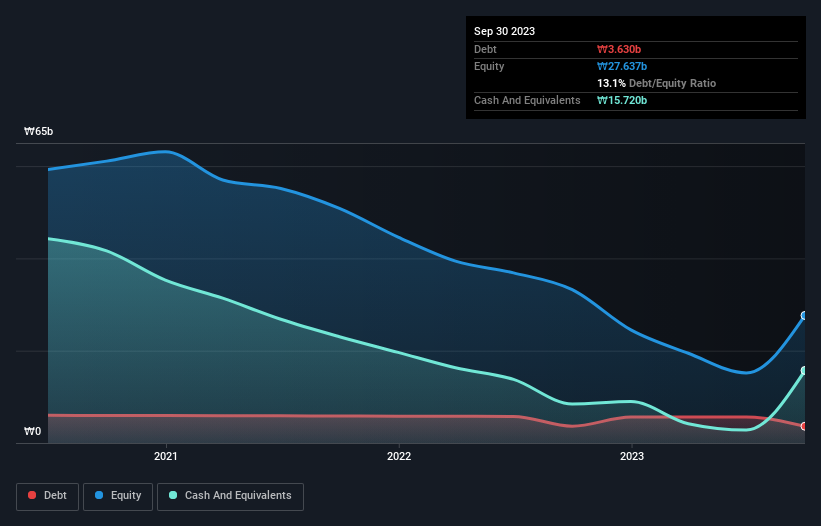Warren Buffett famously said, 'Volatility is far from synonymous with risk.' So it might be obvious that you need to consider debt, when you think about how risky any given stock is, because too much debt can sink a company. Importantly, SCM Lifescience Co., Ltd. (KOSDAQ:298060) does carry debt. But the real question is whether this debt is making the company risky.
Why Does Debt Bring Risk?
Generally speaking, debt only becomes a real problem when a company can't easily pay it off, either by raising capital or with its own cash flow. Ultimately, if the company can't fulfill its legal obligations to repay debt, shareholders could walk away with nothing. While that is not too common, we often do see indebted companies permanently diluting shareholders because lenders force them to raise capital at a distressed price. Of course, the upside of debt is that it often represents cheap capital, especially when it replaces dilution in a company with the ability to reinvest at high rates of return. The first thing to do when considering how much debt a business uses is to look at its cash and debt together.
View our latest analysis for SCM Lifescience
What Is SCM Lifescience's Net Debt?
As you can see below, SCM Lifescience had ₩3.63b of debt, at September 2023, which is about the same as the year before. You can click the chart for greater detail. However, it does have ₩15.7b in cash offsetting this, leading to net cash of ₩12.1b.

How Healthy Is SCM Lifescience's Balance Sheet?
The latest balance sheet data shows that SCM Lifescience had liabilities of ₩1.51b due within a year, and liabilities of ₩3.77b falling due after that. Offsetting this, it had ₩15.7b in cash and ₩111.1m in receivables that were due within 12 months. So it can boast ₩10.6b more liquid assets than total liabilities.
This excess liquidity suggests that SCM Lifescience is taking a careful approach to debt. Because it has plenty of assets, it is unlikely to have trouble with its lenders. Simply put, the fact that SCM Lifescience has more cash than debt is arguably a good indication that it can manage its debt safely. There's no doubt that we learn most about debt from the balance sheet. But it is SCM Lifescience's earnings that will influence how the balance sheet holds up in the future. So if you're keen to discover more about its earnings, it might be worth checking out this graph of its long term earnings trend.
Over 12 months, SCM Lifescience reported revenue of ₩558m, which is a gain of 31%, although it did not report any earnings before interest and tax. With any luck the company will be able to grow its way to profitability.
So How Risky Is SCM Lifescience?
We have no doubt that loss making companies are, in general, riskier than profitable ones. And the fact is that over the last twelve months SCM Lifescience lost money at the earnings before interest and tax (EBIT) line. And over the same period it saw negative free cash outflow of ₩12b and booked a ₩24b accounting loss. But at least it has ₩12.1b on the balance sheet to spend on growth, near-term. SCM Lifescience's revenue growth shone bright over the last year, so it may well be in a position to turn a profit in due course. Pre-profit companies are often risky, but they can also offer great rewards. The balance sheet is clearly the area to focus on when you are analysing debt. But ultimately, every company can contain risks that exist outside of the balance sheet. Case in point: We've spotted 5 warning signs for SCM Lifescience you should be aware of, and 3 of them don't sit too well with us.
When all is said and done, sometimes its easier to focus on companies that don't even need debt. Readers can access a list of growth stocks with zero net debt 100% free, right now.
New: Manage All Your Stock Portfolios in One Place
We've created the ultimate portfolio companion for stock investors, and it's free.
• Connect an unlimited number of Portfolios and see your total in one currency
• Be alerted to new Warning Signs or Risks via email or mobile
• Track the Fair Value of your stocks
Have feedback on this article? Concerned about the content? Get in touch with us directly. Alternatively, email editorial-team (at) simplywallst.com.
This article by Simply Wall St is general in nature. We provide commentary based on historical data and analyst forecasts only using an unbiased methodology and our articles are not intended to be financial advice. It does not constitute a recommendation to buy or sell any stock, and does not take account of your objectives, or your financial situation. We aim to bring you long-term focused analysis driven by fundamental data. Note that our analysis may not factor in the latest price-sensitive company announcements or qualitative material. Simply Wall St has no position in any stocks mentioned.
About KOSDAQ:A298060
SCM Lifescience
Operates in the stem cell therapy, CMO, contract research and consulting, and cosmetic businesses.
Flawless balance sheet with slight risk.
Similar Companies
Market Insights
Community Narratives



